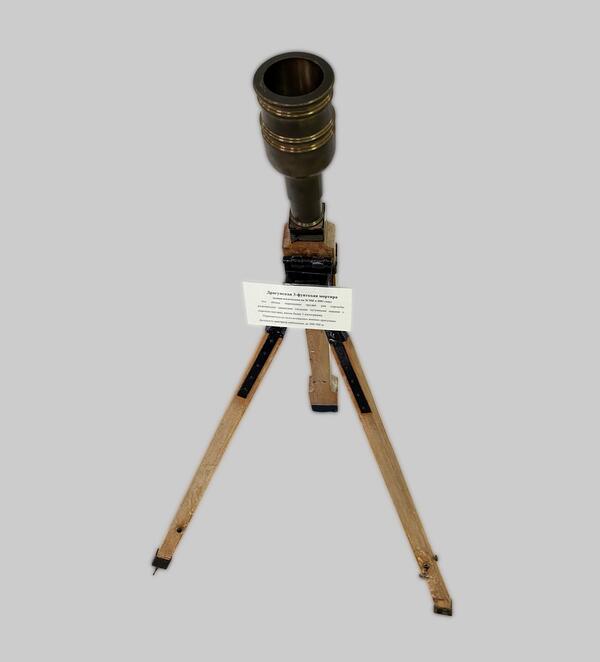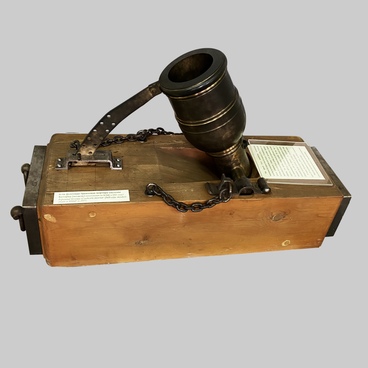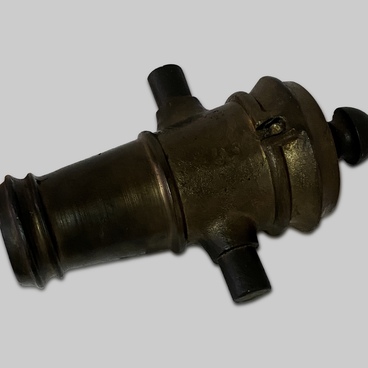Dragoons regiments were one of the first regular troops in Kuznetsk. Olonets dragoon regiment was garrisoned in Kuznetsk for several decenniums.
The dragoons, dismounted combatant forces, were armed with petronels, backswords and special dragoon three-pounder mortars. Those mortars were very light, they were installed on a tripod and could fire 1.2 kg fused grenades. They could be easily transported by horses when disassembled. Exact copies of those mortars were manufactured for the museum at the ZMSK complex using the drawings of XVII century.
A grenade launcher firing grenades came into being in Western Europe late in XVII century, and in Russia — early in XVIII century. The specifics of that weapon is the design of the cannon barrel consisting of two parts: a gun chamber where the grenade was seated, and a narrow cylinder charge case.
There existed three types of hand mortars. Bombardiers and grenadiers of infantry troops used brass or iron bore in an ordinary gun stock. Iron-bore mortars with a long gunstock and a rectangular notch were in service with the dragoons. The third type with a brass bore was used by the Navy. The notch in the mortar gunstock was required to lean the mortar against the saddle or to put it into the slot in the deck. For shooting, the mortar was loaded the same way as an ordinary flint-lock gun.
Different mortars had different chamber size: 45-55 mm in bombardier mortars, 65-75 mm in grenadier mortars, and 70-75 mm in dragoon and Navy mortars. The mortar was and different length: 56- 62 cm in bombardier mortars, 80-85 cm in grenadier, dragoon and Navy mortars. The weight of mortars was 3-5 kg.
Depending on the gun chamber size, mortars could throw 1.5 to 3 pound grenades. The shooting range could achieve 100- 150 m. The use of hand mortars was limited in the earlier half of XVIII century. Later they entered service with fortresses where they survived until early XIX century. The weapon again invited attention early in XX century when a short mortar for throwing grenades was attached to the gun barrel. The shots were blank. Such mortars were used during the First World War, and partially, during the Second World War. Then they were replaced by rifle-attached grenade launchers and rifle grenades.
The dragoons, dismounted combatant forces, were armed with petronels, backswords and special dragoon three-pounder mortars. Those mortars were very light, they were installed on a tripod and could fire 1.2 kg fused grenades. They could be easily transported by horses when disassembled. Exact copies of those mortars were manufactured for the museum at the ZMSK complex using the drawings of XVII century.
A grenade launcher firing grenades came into being in Western Europe late in XVII century, and in Russia — early in XVIII century. The specifics of that weapon is the design of the cannon barrel consisting of two parts: a gun chamber where the grenade was seated, and a narrow cylinder charge case.
There existed three types of hand mortars. Bombardiers and grenadiers of infantry troops used brass or iron bore in an ordinary gun stock. Iron-bore mortars with a long gunstock and a rectangular notch were in service with the dragoons. The third type with a brass bore was used by the Navy. The notch in the mortar gunstock was required to lean the mortar against the saddle or to put it into the slot in the deck. For shooting, the mortar was loaded the same way as an ordinary flint-lock gun.
Different mortars had different chamber size: 45-55 mm in bombardier mortars, 65-75 mm in grenadier mortars, and 70-75 mm in dragoon and Navy mortars. The mortar was and different length: 56- 62 cm in bombardier mortars, 80-85 cm in grenadier, dragoon and Navy mortars. The weight of mortars was 3-5 kg.
Depending on the gun chamber size, mortars could throw 1.5 to 3 pound grenades. The shooting range could achieve 100- 150 m. The use of hand mortars was limited in the earlier half of XVIII century. Later they entered service with fortresses where they survived until early XIX century. The weapon again invited attention early in XX century when a short mortar for throwing grenades was attached to the gun barrel. The shots were blank. Such mortars were used during the First World War, and partially, during the Second World War. Then they were replaced by rifle-attached grenade launchers and rifle grenades.



